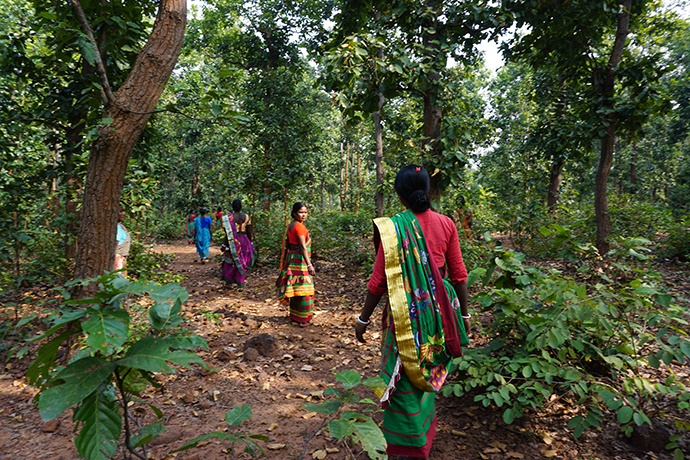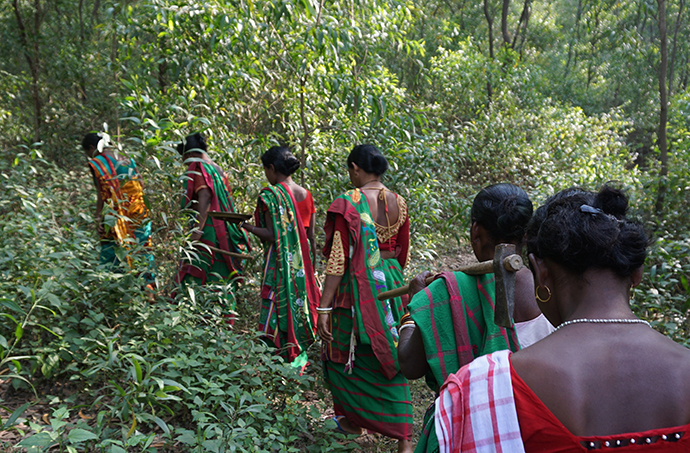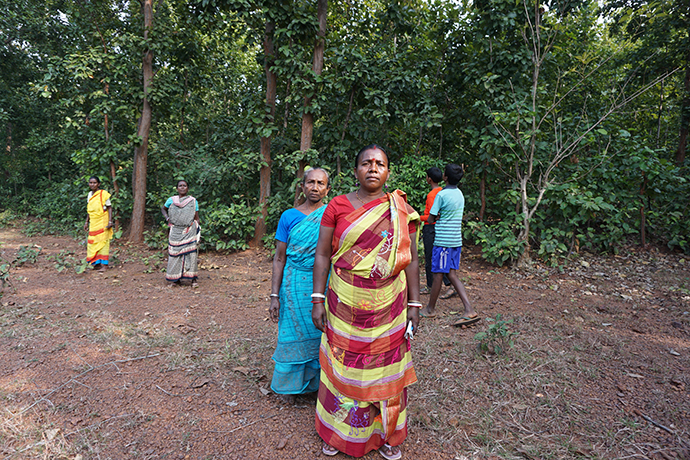A dozen women walked down a leaf-scattered path, clutching weapons. Some held hatchets, others bamboo sticks. They stopped under the canopy of an arjun tree, near cows tethered to its roots, and turned to Jamuna Tudu, their leader. She said the group needed to wait for the others to finish their chores. Moments later, more women arrived. One clasped a small machete in her hand, a toddler resting on her other hip. I had joined them on a morning patrol in the Chakulia jungle that rims their village of Muturkham in Jharkhand, a mineral-rich state in East India that has lost nearly half its forest in the last eighty years. The women were setting out to guard the trees.
The women living in Chakulia comb the forest for several hours a day, looking and listening for what locals call the “timber mafia,” loggers who sell high-value sal and acacia timber to businesses across South Asia. When they’re not in the forest, they listen for the thud of chopping wood, which echoes like an alarm. They follow the sound, encircle the logger, and demand he drop his axe. On this bright morning, as usual, the women had paused their housework to patrol more than 360 acres of jungle outside Muturkham. It is unpaid, risky work.
The women of Muturkham are adivasis, Sanskrit for “original inhabitants,” and belong to the Santal tribe, one of more than seven hundred tribes in India. For centuries, they have depended on India’s forests, using leaves, tubers, roots, and flowers in their diet or for medicine, and worshipping spirits which live among the trees. Santali women shape sal leaves into plates which they sell in the market and collect curry leaves to treat stomachaches. When the sal tree’s tiny, white, star-shaped flowers open in spring, they worship them to promote prosperity and prevent natural disasters.
But during the British Raj in the nineteenth century, colonial officials marked swaths of forests as Crown lands and opened them for commercial use, cutting timber for military bases and railways. Forest officials arrested people for the most minor offenses, such as gathering fodder, a practice which continued after India gained independence.
Today, one of the largest threats to India’s forests is illegal logging. The government has negotiated rights for locals like Tudu to collect “non-timber forest produce,” which includes fallen branches, twigs, and sal leaves. But chopping wood for commercial purposes on national land is illegal. Still, it remains a promising moneymaking venture in a region with few job prospects. Jharkhand is one of India’s poorest states, with 37 percent of its population living below the poverty line. The unemployment rate is over 30 percent, requiring village patrols like the women of Muturkham to constantly be on guard for loggers.

The Mishrikata women patrol the forest outside their village. All photographs by Tricia Taormina.
From a window in my hotel, I could see a skyline full of slender, red-and-white-striped smokestacks. I was staying in Jamshedpur, near the Chakulia forests, one of the only cities in India administered by a multinational corporation. Tata Steel Limited operates its main plant and acts as the city council, managing everything from the water supply to the electricity to the landscaping. Jharkhand is considered the heart of India’s nuclear program, as it harbors most of the country’s resources—coal, iron, gold, copper, and uranium, among others. Jharkhand was created to honor the demands of indigenous people seeking more rights over their land, but with industrial projects displacing them, many say these demands remain largely unmet.
As I drove out of the city and past uranium mines to reach the forest, the land became unearthly. The meadows bordering the highway morphed into metallic hills that shimmered in the sunlight. In the distance, I saw trees and houses and then people, mostly children and women moving between clotheslines.
An hour later, as we walked deeper into the forest, through scrambling wildflowers, the mines seemed distant. I followed the Muturkham women as they trudged through sal trees, hearing nothing but their flip-flops slapping the ground. They sliced through shrubs and snapped off pencil-thin branches, tucking them into their sari blouses to use later for kindling. Tudu guided us up a hill into a clearing from which the women can spot loggers passing through the brush below.
Tudu bellowed out commands, stomping over stones and dried leaves in a pair of high-heeled sandals. She exuded confidence, only faltering slightly when describing a serious run-in with a logger. On a winter night four or five years ago, her group gathered on the railroad tracks of the local train station, shouting at a woman guarding a pile of freshly-cut timber. As they peered into the darkness, trying to make out the loggers, they were hit with large stones. Tudu took two blows to the head, then noticed her husband on the ground, motionless. He survived, but they still haven’t identified the culprits.
Encounters like this have become increasingly rare. For years, the women of Muturkham stopped at least one logger a day, but now the number of incidents has plunged to only a few per year. Inside the clammy forest-department office, which is surrounded by rusted trucks filled with confiscated timber, a group of rangers told me they think the village patrols have helped curb illegal logging. In the late 1980s, India adopted policies to involve communities in forest management. Of around 250 forest patrols in Chakulia, at least 50 of them are composed mostly of women. But the government is now considering a law that would open up some forests to private industry.
“Today it’s a small area the women are protecting,” says Purabi Bose, a researcher focused on forestry and indigenous rights. “But if there’s a bigger interest in the future, are they good enough to fight it out with bigger companies?” Many women guarding India’s forests, like those in Chakulia, might not have the knowledge or legal resources to push back against private corporations lobbying the government for more access to timber. Bose says India’s wider set of laws also ignore women’s roles in forestry, which means they’ll continue to be excluded from policies that would help them protect their land.

Jamuna Tudu leads the Muturkham women through the forest outside their village.
Later, I joined a different patrol on the east end of Chakulia, near the villages of Mishrikata and Murathakura. Sombari Murmu, a short and quiet woman, directed the group with gestures more than words. She swung her arms into the air and pointed as she led us down a path lined with tiny acacia trees. Sombari and her neighbors patrol their forest area twice a day for two to three hours at a time. The women set out alone in the mornings and around twenty villagers, including children, conduct the last patrol before dusk.
Within minutes, Sombari was standing over a jagged tree stump. “They must have come at midnight,” she said. The villagers accompanying us—middle-aged men and women, teenage boys, and small children—flocked toward the stump and launched into theories. It may have been so-and-so from the neighboring village, young men desperate for work or preparing for a festival. They said the loggers usually enter the forest after the group ends their evening patrol.
We walked until we reached an open space hedged in by towering sal trees. Sombari explained it as a juncture between villages, an area loggers pass through on their way to Mishrikata’s end of the forest. Her group hides there at night, waiting for a rustle or blur that might signal an intruder. Sombari has rarely caught an illegal logger in person, so she relies on rumors to find them, making phone calls and even showing up at people’s houses to inspect their wood supply. I noticed strands of white thread wrapped around a batch of trees, like a bow. It was a rakhi, tied onto them during Raksha Bandhan, a festival that celebrates the relationship between siblings. “It gives a message to them to consider these trees as a brother,” said Sombari.
The women wandered farther while the men and children stayed behind. The forest dimmed and then brightened as streams of light filtered between the trees. Eventually, they split up and dispersed among the brush in sync, as if choreographed. There were no paths to follow and I asked Sombari if they ever get lost. “This is my home,” she said. “How can I get lost here?” At night, they follow the moon to find their way out of the woods.

Sombari Murmu stands at the edge of the forest near Mishrikata village.
As we walked back to Mishrikata in the hazy evening light, through a field of pale grass and stinging nettle, Sombari echoed a sentiment I had heard other women express earlier: they protect the forests for both financial and spiritual reasons. Like Sombari, many local women never finished primary school and can’t find work outside construction or picking crops on someone else’s fields. Collecting firewood saves them money and selling sal leaves in the market provides an extra income of about five hundred rupees (around seven dollars) per month. But it requires them to sacrifice their days guarding the jungle. Like other women, Sombari wishes the forest department would compensate them for the patrols. “This is painful for us,” she said.
When we arrived at Sombari’s house, her husband stumbled out the door, drunk and muttering. She seemed hesitant to articulate what became obvious. They both work odd jobs to make ends meet, but she schedules her time around patrolling the forest. Her granddaughter and a friend greeted us, in school uniforms and red-bowed braids. They laughed when talking about how they forget to do their homework when they’ve spent an evening in the forest, but said they plan to keep guarding it when they are older. “I go because everybody else goes,” said one of them in Hindi, the language she is learning at school. “The forest is our life.”
Leaving the village, I drove down a highway under construction, back toward the steel city and the mines, past screeching bulldozers and people cycling through billows of dust. When it cleared, I could see the setting sun, growing red and blotting out the horizon. The land was flat and there were no trees in sight.


